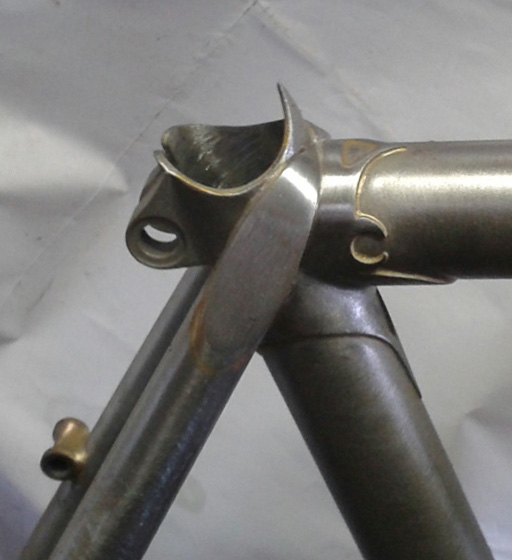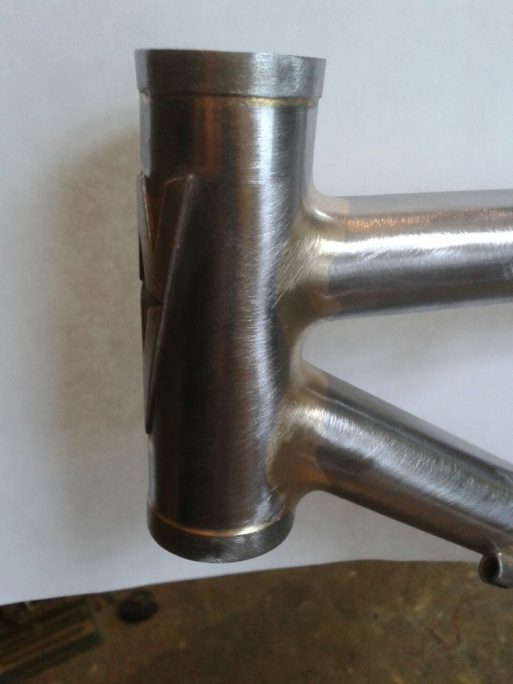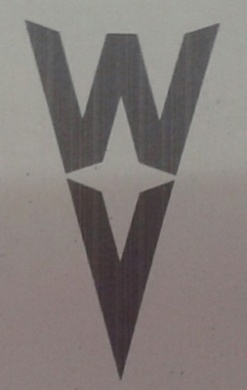Vol. 2, Issue 55 - January / February 2015
Posted: Thursday 15th January 2015
THE CLASSIC CYCLIST’S NEW YEAR QUIZ, 2015 by Geoff Waters
Attempt all 25 questions. Each question counts 2 marks. Answers and score ratings at the end
1. When did the UCI first introduce world title events for women?
a) 1957 b) 1958 c) 1959 d) 1960
2. At which one of the following pre-WWII British Empire Games were cycling events first introduced?
a) Hamilton 1930 b) London 1934 c) Sydney 1938
3. Who is the 1960s British time trial star whose name is hidden in the following?
SERGE FLAN
4. In 1962, who became the first Eastern bloc rider to win the British ‘Milk Race’:
a) Eugen Pokorny b) Jozef Gawilezek c) Jiri Mainus
5. Which one of the following classic British lightweight frame builders was based in Rusholme, Manchester?
a) Ken Bird b) Harry Quinn c) Johnny Berry d) Alan Shorter e) Bill Hurlow
6. During the ‘Cold War’, which Eastern bloc country won NINE UCI world tandem sprint track championships in the 30 years between 1958 and 1988?
a) Soviet Union b) Poland c) East Germany d) Czechoslovakia
7. What is the name of the classic British lightweight components hidden in the following?
CLEAR HATE
8. What word, initially, would an intelligent cyclist’s thought be on studying the following list of opera titles by Verdi?
Tosca – Aida – Nabucco – Don carlos – Ernani – Macbeth
9. In 1969, who became the first American woman cyclist to win a UCI world championship?
a) Rebecca Twigg b) Connie Carpenter c) Audrey McElmury
10. The classic Percy Stallard ‘Zacopane’ model of road machine was named after the town in which the British roadman, Geoff Clarke, riding a Stallard, won a stage in the 1949 edition of the:
a) Giro della Regione b) Peace Race c) Tour of Poland d) Tour de l’Avenir e) Vuelta
11. The Soviet woman sprinter who won SIX UCI women’s match sprint titles between 1958 and 1972 was:
a) Raisa Obodovskaya b) Tamara Garushkina c) Galina Ermolaeva d) Vera Savina
12. The continental cycling term, development/‘développement’, refers to:
a) The diameter of the bicycle’s rear wheel
b) The number of teeth both on the chainwheel and on the rear sprocket (eg. 50×13)
c) The distance travelled in metres in one complete revolution of the pedals
d) The orbit of the pedal as determined by crank length
13. Which one of the following leading 20th century American novelists was a great fan of cycle sport during his lifetime?
a) JD Salinger b) Ernest Hemingway c) Scott Fitzgerald d) John Steinbeck
14. Who was the first cyclist from the Soviet Union to win the Olympic road title when he triumphed at the 1960 Rome Olympic Games?
a) Sergei Soukorouchenkov b) Viktor Kapitanov c) Yevgeni Berzin d) Vladimir Osokin
15. He won the 1960 Olympic road title riding an Italian machine built by:
a) Colnago b) De Rosa c) Frejus d) Cinelli e) Gios f) Bianchi g) Wilier Triestina
16. Who was the lone British Ellis-Briggs Cycles-sponsored rider who won the 1952 Tour of Britain?
a) Ian Steel b) Ken Russell c) Des Robinson d) Bill Bradley
17. Who was the Italian cyclist who beat Reg Harris to the match sprint title at the 1948 London Olympics?
a) Antonio Maspes b) Leandro Faggin c) Mario Ghella d) Enzo Sacchi
18. Which one of the following classic cyclists never held the world hour record?
a) Ferdi Kubler b) Fausto Coppi c) Roger Riviere d) Guiseppe Olmo e) Roger Slaats
19. Which one of the following cyclists does not feature in a biography published by Mousehold Press?
a) Dennis Horn b) Tony Hewson c) Vin Denson d) Shay Elliott e) Frank Southall
20. Which one of the following classic makes of Italian lightweight was associated with Gino Bartali in his heyday?
a) Frejus b) Legnano c) Bianchi d) Masi e) Wilier Triestina f) Cinelli
21. With which famous British cycling club is the ‘Muratti Cup’ trophy (first awarded in 1899) associated?
a) Bath Road CC b) Catford CC c) Manchester Wheelers d) Anfield Bicycle Club
22. Who was the Australian cyclist who won the Commonwealth Games match sprint title in both 1970 and 1974 and then the UCI professional match sprint title in 1975?
a) Gordie Johnson b) Danny Clarke c) John Nicholson d) John Trevorrow
23. Which one of the following was not a classic French-built lightweight?
a) Plum Vainqueur b) Lejeune c) Peugeot d) Stella e) Urago g) André Bertin
24. By the end of the 1970 Commonwealth Games held in Edinburgh, Scotland, which one Commonwealth country had won a grand total of 17 cycling gold medals in all of the Games held up until that date?
a) Australia b) Canada c) England d) New Zealand
25. A well-known classic lightweight bicycle aficionado noted for going ‘Round the Horn’.
Who is the man in the anagram?
ONE REPUTED WORD
Remarking upon the grease nipple in the axle end of the Chater-Lea hub in L N 54 reminded me the extent to which some riders went in the quest for that little extra speed: some cleaned all the grease out of wheels, bottom brackets, etc and used oil as a lubricant in lieu. The idea obviously was to reduce drag and friction on moving parts, usually on a bike they used mainly for competition. There is no doubt that the wheels spin beautifully on oil but it is obviously necessary to keep them this way by regular injections. It is amazing the state of the grease on some older bikes where the grease has solidified and ‘pulled away’ from the surfaces intended to be lubricated. I have had to dig out this solid grease using a screwdriver as a spade.
Another lubrication puzzle is that of new chains. I don’t know what the manufacturers use but a new chain is so sweet and smooth that I try to keep it this way as long as possible by keeping the chain dry (and thus clean) as long as I can. Once one finally has had to clean and lubricate the chain it loses that sweetness. I’m sure I have mentioned before that there are at least two ways to lubricate a chain and I use the ‘dry’ method by spraying with a product known as GT85 in the UK. This has to be done about once a week in dry conditions plus any time the chain is exposed to wet conditions. The advantage is that the chain is always clean hereas other methods seem to ensure that the chain is filthy within a few hours of riding.
You may remember the story about my acquisition of a Gillott Fleur de Lis (sic) frame in the last edition of Lightweight News. I have now moved a step forward, having taken the frame to Mario Vaz for respraying. It was good to see Mario again as he is such a nice chap and it is always worth the journey to see all the beautifully restored frames awaiting collection.
There are always several models of Colnago which he does for a regular customer plus a selection embracing most of the British classics. Mario worked for Holdsworth for several years before setting up on his own account in SE London. Mario’s brother Winston also worked for Holdsworth as a frame builder and then moved on to Chas. Roberts where he built frames for many years. Winston has now left Roberts and taken up a workshop in the space below Mario’s paint shop. Sadly, we didn’t get to meet him when we travelled to London with the frame, fork and stem but Mario showed us round his workshop and it was illuminating to see the superb craftsmanship on some frames he had on the go.
One was being built with Newex lugs, a modern version of the ubiquitous Nervex Professional lug , which are now produced in America. Winston had added his own touch with a few deft changes including a window on top of the seat lug which you can see in the shot below. Unfortunately, I only had my phone with me but it is amazing the quality of phone cameras these days.
This one shot shows the standard of Winston’s work which comes from so many years of building top-class classic steel frames. There was also a brazed frame with a beautiful smooth finish to the junctions. It is a long time since I have seen such finishing on a ‘raw’ frame. It is lucky for such craftsman that there is now an upsurge of interest in custom-built frames due to some degree to the fixed-wheel scene which is so strong especially in urban areas, including London.
Luckily when I collected the frame a couple of weeks later, (more in Lightweight News 56), Winston was there and we had a long chat about his new venture where his frames will be known as VARONHA with a very attractive stainless steel badge brazed onto the head tube.
Many touring people also seem to like steel for their frame and I can see the sense in this as most carbon frames are built down to a weight with competition in mind. Having a custom-built steel frame means that you can tailor the build exactly to suit your needs. My days of serious touring are probably over but my winter bike, a titanium Van Nicholas Yukon has bosses on the seatstays for a carrier and I have one which I can fit in two to three minutes – just four bolts tightened with an allen key. We did revisit the Romantische Strasse in Germany a couple of years ago and I was quite happy to carry the luggage for two as we only did a few days at a time and we were able to use the bike bus that travels the route each way every day to return to our base.
Now the Gillott is here at home having had a replate and repaint I had the nerve-racking job of fitting bottom bracket and headset without scratching the paint with the large unwieldy tools needed.
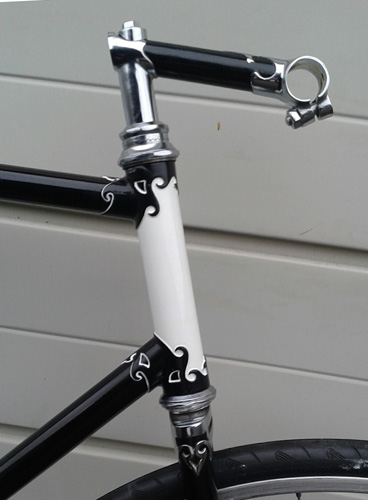
Having had a good clear-out to deter me from acquiring more bikes I now find I have no bars to fit this stem. I only have Cinelli and Kint Maes Van Steenbergen bars (which have a ferrule, making them too wide).
As you can see from the image above, my next task is to fit a front brake and I have already tried a GB Coureur which as usual has a very one-sided look as there is no attempt in manufacture to rectify the offset of the two arms. I also puzzle as to why all my GB brakes have at least one arm twisted putting the block at an angle to the rim. I also have a Weinmann, or rather two, a 730 and a 500 which I am reluctant to use and I am puzzled as to why this is. The Weinmann was first advertised in Aids to Happy Cycling (the time-trial cyclists bible of the time) in 1951 at 43/6d which was a few shillings more than GB. The advert says. “Swiss precision and finish”. Why am I reluctant to fit it I think comes back to my formative years being in time trial country and there was no crossover with massed start due to the battles and hatred between to organising bodies of each. Books have been written on this subject.
I can imagine the Leaguers with these foreign Weinmann brakes on their Continental machines with fancy gears and kit and plain ‘Italia’ lugs. In the other camp the time trial brigade had fixed-wheel British bikes with fancy lugs and British kit such as Chater-Lea, Harden, Bayliss Wiley and GB.
Sometimes I think this prejudice of mine comes from a theory I have never shared before. It is that classic builders who came to an abrupt end are held in higher esteem than those bought out and continued over years by large companies. Maybe the classic example is Claud Butler, Mr Lightweight in his time, but now the name is associated with cheap Far-Eastern imports badged with the once respected name.
Compare this with Ephgrave, say, who ceased trading and that was it – the name is revered until this day. Some other lightweight names went the same way as Claud Butler and have suffered as well.There is an in-between situation where the name was carried on but frames were hand built and obviously kept to small numbers. A classic example is the Condo- produced version of the classic Paris marque.
I wonder if the respect can be reinstated? We shall see now that Planet X have bought out the Holdsworth name and are producing high quality frames in Italy. At least Dave at P X knows what he is doing after the Holdsworth name has been ‘rescued’. Ironically, the Paris frames are also produced in Italy. We do still have artisan builders in the UK but I guess they are not geared to producing the extra numbers the new owners will need to make the venture worthwhile.
The Seat Post man
Offers a useful service if you have a frame with a ‘stuck’ seatpost. There are several DIY ways of doing this but if the post doesn’t move with a bit of persuasion then it is worth considering contacting “The Seat Post Man“. especially if your frame has a value. The copy below is taken from The Seat Post Man’s very informative website:
Our company specialises in removing tight or seized seatposts from bicycle frames using a totally unique method which aims to withdraw the post allowing it to be reused. This method of removal is only available from The Seatpost Man in Chorley, Lancashire, UK.
Problem
A stuck or seized bicycle seatpost can mean anything from a nuisance to a new frame or even a complete new bike. With more varied frame/seatpost combinations being available in differing materials the problem of a stuck post in a bicycle frame is not uncommon. This can occur for several factors, the most common being corrosion/oxidisation between the seatpost and the internal wall of the frame which can happen in as little as a few months. This kind of bond can be almost total. Another could be poor tolerances between these two components, which is especially true when parts are used from different manufacturers.
Solutions
Most DIY removal methods involve twisting the post out using brute force, painfully laborious sawing techniques, or the use of strong caustic solutions ( I use none of the above!) While sometimes these approaches may be successful there is a real risk of frame damage or even bodily harm if these methods go awry. Also all of the above will damage the seatpost beyond use in most cases.
Our Approach
Almost twenty years ago a friend asked me to attempt to remove a seized seat post from an old BMX frame. My method was successful and was my inspiration when more recently another friend asked me the same thing. As this seatpost was in great condition I designed and fabricated a tool to remove it, with little or no marking, to allow it to be reused, and have since used this method to great effect on more customers bikes. I have now increased my tooling and can remove damaged or fully seized seatposts from most frames. Contact John: john(at)theseatpostman.com
Colnago – Everyone seems to have trouble identifying the different models produced over the early years by Colnago. The following extracts were from a discussion on the LFGSS Forum. The first, which was straightforward stated:
If it has four crimps on the downtube, it is a Mexico. If it has two crimps on the down tube it is a Super
However, contributor Saarf went into much more detail as you will see:
”Basically
Merckx Colnago Mexicos (1974-1979) had round superlight main tubes,
Sarroni Nuovo Mexicos (1980-1985) crimped top and down tubes, ESA Mexicos (1986-1988) had 6 ribs on main tubes,
Zoetemelk Mexico SR/CRs (1985-1986) had a crimped top tube with a 4-rib downtube.
Further information:
Master with 4 ribs, Tecnos with 5 ribs, Conic with 8 ribs, and Regal (ESA Mexico w/Arabesque lugs) with 6 ribs. The visible difference between 1974-’79 Mexico and 1974-’79 Super is that the Mexico has chainstays that are not crimped at all (round-oval-round)
Masi (round-D-round), De Rosa (round-diamond-round).
(Note that the timelines are for the USA)
My name is Adrian Lipscombe and I am a bicycle coordinator for the City of Austin, Texas. I am also a Ph.D. student at the University of Texas at Austin. I research history of bicycling and attitude and behaviour of bicyclist. At the moment I study attitude and behaviour of minorities towards bicycling. I have become good friends with Andrew Ritchie a historian, who researches Major Taylor. He let me know that my last name was ironic due to he is from London, and as you may see my last name is Lipscombe. I am interested in Frank Lipscombe past and his frame making, and was wondering if you have seen or heard anyone selling one of his bikes? I would find it an honour to have one and to find out more about them. Seeing that I am in U.S. it is very difficult to gather information on them.
Barry Adams – I am after a few of items for my Shorter rebuild:
a pair of 28-hole wood insert rims or wheels.
A pair of 28-hole large flange Airlite hubs either double fixed or fix and freewheel. Condition of chrome is not important.
A complete TDC Italia head set in very good condition.
Peter Underwood has for sale:
24″ Bates Vegrandis, 1952 frame and forks, as listed in Readers’ Bikes on the Classic Lightweights website. Headset included but not bottom bracket. Selling to make room for a Gillott Fleur de Lis acquired from the estate of a friend who recently died. Very good condition – £450
Also:
Pair of ‘Youngs Miche 20’ 650 wheels with Shimano freehub. 24 spoke rear, 20 spoke front. Fitted Vittoria Rubino Pro tyres. 300 miles use only so in as-new condition. £65
Both collect from Cambridge.
Peter Beaven: A friend of mine has a 1952 R.O.Harrison Madison model for sale. Nice Presta track stem, but other components rather more modern.
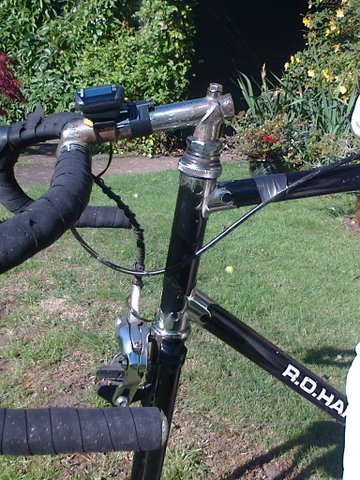
ANSWERS TO CLASSIC QUIZ 2015
1. b) 1958 (Three events: road race; individual pursuit; match sprint)
2. b) London 1934 (Three track events: 1,000 yards sprint; 1,000 metres individual TT; 10 mile scratch race. The events were held at Fallowfield track, Manchester)
3. Alf Engers
4. a) Eugen Pokorny [Poland]
b)Jozef Gawilezek [Poland] won in 1966 and c) Jiri Mainus [Czechoslovakia] in 1970
5. c) Johnny Berry
6. d) Czechoslovakia
7. Chater Lea
8. TANDEM
(Source: Colin Dexter’s Inspector Morse novel, The Remorseful Day, 1999, p.373)
9. c) Audrey McElmury. (Won the 1969 road event held in Brno, Czechoslovakia)
10. c) Tour of Poland 1949
11. c) Galina Ermolaeva (Won UCI sprint title in 1958,1959,1960,1961,1963, and 1972)
a) Raisa Obodovskaya – Won UCI indiv. pursuit title 1962, 1965 & 1967
b) Tamara Garushkina – Won UCI indiv. pursuit title 1968 & 1969
d) Vera Savina – Won UCI sprint title 1962, 1965 & 1967)
12. c) The distance travelled in metres in one complete revolution of the pedals
13. b) Ernest Hemingway
14. b) Viktor Kapitanov
15. d) Cinelli
16. b) Ken Russell
17. c) Mario Ghella (Also won 1948 UCI world amateur sprint title; turned pro but had little further success)
18. a) Ferdi Kubler
Years in which the following broke the hour record:
b) Fausto Coppi-1942
c) Roger Riviere-1957 & 1958
d) Guiseppe Olmo-1935
e) Roger Slaats-1937
19. e) Frank Southall
Publications by Mousehold Press:
a) Peter Underwood, Dennis Horn-racing for an English rose
b) Tony Hewson, In Pursuit of Stardom
c) Vin Denson, The Full Cycle-Vin Denson
d) Graham Healy, Shay Elliott: the life and death of Ireland’s first yellow jersey
20. b) Legnano
21. c) Manchester Wheelers (Muratti Cup donated by Messrs B Muratti, Sons & Co,
22. c) John Nicholson
23. a) Plum Vainqueur (made in Ghent, Belgium)
24. a) Australia-17 Commonwealth Games cycling gold medals, 1934-1970
b) Canada-2 golds; c) England-13 golds; d) New Zealand-2 golds)
25. Peter Underwood
SCORING
(Total = 50 marks)
MARKS
40-50: You are a classic cycling expert!
30-39: Well done!
20-29: Getting there!
10-19: Room for improvement!
<10: Must try harder!
Posted: Thursday 15th January 2015
This article appears in the following categories.
Upcoming Events
Whether you are looking for a gentle social meet up, or a 100-mile ride browse the community’s upcoming events and plan your next weekend outing.

